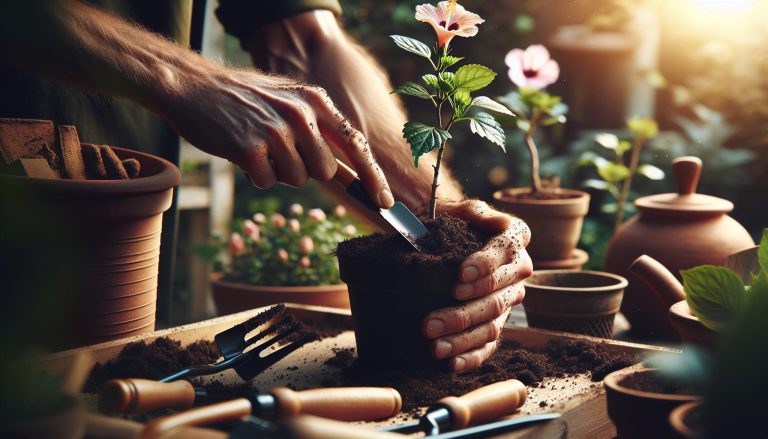Best Insecticide for Hibiscus: Top Picks to Protect Your Blooms
As a passionate gardener, I’ve spent years nurturing my hibiscus plants to achieve those stunning, vibrant blooms. But I’ve also faced the frustrating challenge of pesky insects threatening their health and beauty. If you’re like me, you’ve probably wondered: What’s the best insecticide for hibiscus?
With so many options on the market, finding the right solution can be overwhelming. That’s why I’ve done the research and testing to bring you the most effective and safe insecticides for your beloved hibiscus. In this article, I’ll share my top picks and expert tips to help you protect your plants from common pests like aphids, spider mites, and whiteflies. Ready to say goodbye to those unwanted garden guests and hello to flourishing hibiscus?
Understanding Hibiscus Pests
Identifying and addressing hibiscus pests is crucial for maintaining healthy, vibrant plants. As a gardener, I’ve learned that early detection and proper management are key to protecting these beautiful flowers from destructive insects.
Common Insects That Attack Hibiscus
Hibiscus plants attract several pesky insects:
- Aphids: Tiny, soft-bodied pests that cluster on new growth
- Spider mites: Microscopic arachnids that cause stippling on leaves
- Whiteflies: Small, white, flying insects that congregate on leaf undersides
- Mealybugs: Cotton-like pests that suck sap from stems and leaves
- Japanese beetles: Metallic green beetles that skeletonize leaves
- Thrips: Slender insects that cause silvery patches on foliage
Each of these pests has unique feeding habits and can quickly multiply, causing significant damage to hibiscus plants if left unchecked.
Signs of Pest Infestation
Recognizing pest problems early is vital for effective control:
- Leaf discoloration: Yellowing or bronzing leaves often indicate spider mites
- Sticky residue: Honeydew secreted by aphids and mealybugs
- Distorted growth: Curled or twisted leaves suggest aphid activity
- Visible insects: Clusters of pests on stems, leaves, or flower buds
- Leaf damage: Holes, ragged edges, or skeletonized leaves from beetles
- Sooty mold: Black fungal growth on honeydew-covered surfaces
- Stunted growth: Overall plant weakness due to sap-sucking pests
Regular inspection of hibiscus plants, including leaf undersides and stem joints, helps catch infestations before they become severe. By familiarizing yourself with these signs, you’ll be better equipped to protect your hibiscus and maintain its health and beauty.
Types of Insecticides for Hibiscus
Selecting the right insecticide for hibiscus plants is crucial for effective pest control. I’ve found that various options are available, each with its own strengths and applications. Let’s explore the two main categories: chemical insecticides and organic alternatives.
Chemical Insecticides
Chemical insecticides offer powerful and fast-acting solutions for pest control on hibiscus plants. Here are some effective options:
- Systemic insecticides: These products are absorbed by the plant and spread throughout its tissues, providing long-lasting protection.
- Imidacloprid: Effective against aphids, whiteflies, and other sap-sucking insects
- Acephate: Controls a wide range of pests, including thrips and mealybugs
- Contact insecticides: These work by directly killing insects on contact.
- Malathion: Broad-spectrum insecticide effective against various pests
- Pyrethrin: Fast-acting and derived from chrysanthemum flowers
- Insecticidal soaps: These products disrupt the cell membranes of soft-bodied insects.
- Potassium salts of fatty acids: Effective against aphids, mealybugs, and spider mites
When using chemical insecticides, always follow the label instructions carefully to ensure safety and effectiveness.
Organic and Natural Options
For gardeners preferring eco-friendly solutions, organic and natural insecticides offer effective pest control without harsh chemicals:
- Neem oil: A versatile organic insecticide that disrupts insect feeding and reproduction.
- Targets: Aphids, whiteflies, mealybugs, and spider mites
- Application: Mix with water and spray on foliage every 7-14 days
- Horticultural oils: These suffocate insects and their eggs.
- Types: Mineral oil, vegetable oil, or fish oil
- Best for: Overwintering pests and early-season infestations
- Diatomaceous earth: A natural powder that damages insects’ exoskeletons.
- Application: Sprinkle around the base of plants or dust on foliage
- Effective against: Crawling insects like ants and beetles
- Beneficial insects: Introduce natural predators to control pest populations.
- Ladybugs: Consume aphids and other small insects
- Lacewings: Feed on various soft-bodied pests
- Praying mantises: Generalist predators that eat many types of insects
- Homemade remedies:
- Garlic spray: Crush garlic cloves, mix with water, and strain before spraying
- Soap solution: Mix 1 tablespoon of liquid dish soap with 1 quart of water
These organic options often require more frequent application but provide a safer alternative for pollinators and beneficial insects in your garden.
Top-Rated Insecticides for Hibiscus
When it comes to protecting your hibiscus plants, choosing the right insecticide is crucial. I’ve tested numerous products over the years and narrowed down the top options for different needs and preferences.
Best Overall Insecticide
Systemic insecticides offer long-lasting protection for hibiscus plants. The Bonide Systemic Insect Control stands out as the best overall option. It’s absorbed by the plant’s roots and distributed throughout its tissues, providing up to 8 weeks of protection against common hibiscus pests.
Key features:
- Active ingredient: Imidacloprid
- Application method: Soil drench
- Duration of protection: 6-8 weeks
- Targets: Aphids, whiteflies, mealybugs, scale insects
Pros:
- Long-lasting protection
- Easy to apply
- Doesn’t leave residue on leaves
- Rainproof once absorbed
Cons:
- Not suitable for edible plants
- May harm beneficial insects if overused
Best Budget-Friendly Option
For gardeners on a tight budget, Safer Brand Insect Killing Soap offers effective pest control at an affordable price. This contact insecticide kills pests on contact while being gentle on plants.
Key features:
- Active ingredient: Potassium salts of fatty acids
- Application method: Spray
- Duration of protection: Immediate, reapply as needed
- Targets: Soft-bodied insects like aphids, mealybugs, spider mites
Pros:
- Inexpensive
- Safe for use on edible plants
- Biodegradable
- Doesn’t harm beneficial insects
Cons:
- Requires frequent reapplication
- Less effective on hard-bodied insects
Best Organic Solution
Neem oil is the top choice for organic gardeners looking to protect their hibiscus plants. Dyna-Gro Pure Neem Oil is a high-quality, cold-pressed neem oil that effectively controls a wide range of pests.
Key features:
- Active ingredient: Azadirachtin
- Application method: Spray (mixed with water and mild soap)
- Duration of protection: 7-14 days
- Targets: Aphids, whiteflies, spider mites, scale insects, fungal diseases
Pros:
- OMRI listed for organic use
- Acts as both insecticide and fungicide
- Safe for beneficial insects when used correctly
- Biodegradable
- Strong odor
- Requires proper mixing and application
- May need frequent reapplication in severe infestations
Factors to Consider When Choosing an Insecticide
Selecting the right insecticide for your hibiscus plants is crucial for effective pest control and plant health. Here are key factors to keep in mind when making your choice:
Safety for Plants and Pollinators
When choosing an insecticide for hibiscus, prioritize products that are safe for both your plants and beneficial insects. Look for formulations specifically labeled for use on hibiscus or ornamental plants. Opt for products with low toxicity to bees and other pollinators. Neem oil and insecticidal soaps are generally safer options, as they break down quickly and have minimal impact on non-target organisms.
Ease of Application
The insecticide’s application method can make a big difference in your pest control routine. Consider products that come with ready-to-use sprayers for quick and convenient application. For larger gardens, concentrate formulas that can be mixed with water might be more cost-effective. Systemic insecticides offer ease of use, as they’re typically applied to the soil and absorbed by the plant, reducing the need for frequent reapplications.
Residual Effect
The longevity of an insecticide’s effectiveness is a crucial factor. Products with a longer residual effect require less frequent applications, saving you time and effort. Systemic insecticides often provide extended protection, lasting several weeks to months. However, contact insecticides may need more frequent reapplication, especially after rain or watering. Balance the residual effect with safety considerations, as longer-lasting products may have a higher environmental impact.
Proper Application Techniques
Effective insecticide application is crucial for protecting hibiscus plants from pests. Mastering the right techniques ensures optimal results and minimizes potential harm to your plants and beneficial insects.
Timing and Frequency
Apply insecticides early in the morning or late in the evening when temperatures are cooler. This timing reduces the risk of leaf burn and allows the product to dry before pollinators become active. Treat hibiscus plants every 7-14 days, depending on pest pressure and the insecticide’s residual effects. During severe infestations, increase application frequency to every 5-7 days. Always follow the product label for specific timing and frequency recommendations.
For systemic insecticides:
- Apply in early spring before pest activity peaks
- Reapply every 6-8 weeks throughout the growing season
- Avoid application during flowering to protect pollinators
For contact insecticides:
- Apply at first sign of pest activity
- Repeat applications weekly until pests are under control
- Monitor plants regularly to catch infestations early
Protective Measures
Taking precautions during insecticide application safeguards your health and the environment. Here’s a list of essential protective measures:
- Wear proper personal protective equipment (PPE):
- Chemical-resistant gloves
- Long-sleeved shirt and long pants
- Closed-toe shoes
- Safety goggles
- Respirator (if using fine mist sprayers)
- Mix insecticides in a well-ventilated area, away from children and pets
- Use clean, dedicated equipment for measuring and mixing
- Apply on calm days to prevent drift
- Cover nearby plants to avoid overspray
- Avoid eating, drinking, or smoking while handling insecticides
- Wash hands thoroughly after application
- Store insecticides in original containers, out of reach of children and pets
- Dispose of empty containers according to local regulations
Remember, proper application techniques and protective measures are key to effectively managing pests on your hibiscus plants while minimizing risks to yourself and the environment.
Preventive Measures to Reduce Pest Problems
Preventing pest infestations on hibiscus plants is far easier than treating them. Here are some effective strategies I’ve learned over the years:
- Maintain plant health:
- Water deeply and regularly
- Fertilize with balanced nutrients
- Prune dead or diseased branches
- Practice good garden hygiene:
- Remove fallen leaves and debris
- Sanitize gardening tools
- Dispose of infected plant material properly
- Encourage beneficial insects:
- Plant nectar-rich flowers nearby
- Avoid broad-spectrum pesticides
- Install insect hotels or bee houses
- Use physical barriers:
- Apply sticky traps for flying pests
- Install row covers during peak pest seasons
- Place copper tape around pots to deter snails and slugs
- Implement companion planting:
- Marigolds repel aphids and whiteflies
- Nasturtiums act as trap crops for aphids
- Garlic and chives deter many common pests
- Regularly inspect plants:
- Check undersides of leaves
- Look for signs of stress or damage
- Act quickly at first sight of pests
- Maintain proper spacing:
- Allow air circulation between plants
- Reduce humidity that attracts pests
- Make it harder for pests to spread
- Use organic mulch:
- Suppress weed growth
- Retain soil moisture
- Promote beneficial soil organisms
By implementing these preventive measures, you’ll create a robust defense against pests and reduce the need for insecticides. Remember, a healthy hibiscus is naturally more resistant to pest attacks.
Conclusion
Protecting your hibiscus plants from pests doesn’t have to be a daunting task. With the right insecticides and preventive measures I’ve shared you’ll be well-equipped to keep your hibiscus thriving. Remember it’s not just about treating problems but also creating an environment where pests are less likely to thrive.
By combining effective insecticides with smart gardening practices you’re setting the stage for healthier more resilient hibiscus plants. Your efforts will pay off with vibrant blooms and lush foliage making your garden a true showstopper. Happy gardening!







